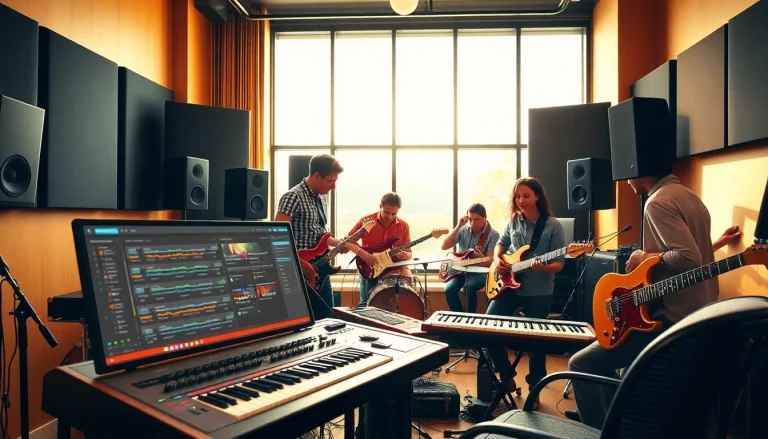Understanding Music Pitching
Music pitching is a critical aspect of an artist’s journey, serving as a gateway to sharing their creations with a wider audience. Whether you are an established musician or an emerging talent, mastering the art of music pitching can significantly elevate your career. In a music industry driven by streaming platforms and social media, the ability to effectively pitch your songs is essential for securing placements on playlists, gaining exposure to curators, and ultimately building a fanbase.
What Is Music Pitching?
At its core, music pitching refers to the process of presenting a song to potential promoters, curators, or industry professionals with the goal of obtaining placements or support. This could include getting feature slots on online playlists, radio stations, or music blogs. A successful pitch encapsulates the essence of the music while also addressing the interests of the recipient, making it crucial to understand who you are pitching to and why your music aligns with their platform.
Why Music Pitching Matters for Artists
The significance of music pitching cannot be overstated. Here are several reasons why it’s paramount for artists:
- Increased Visibility: A successful pitch can lead to increased streams and exposure, helping artists reach new listeners.
- Builds Industry Relationships: Networking with curators and bloggers fosters connections that can lead to future opportunities.
- Validates Your Music: Getting featured on respected platforms can serve as a form of validation, helping to boost an artist’s credibility.
- Enhances Marketing Efforts: A well-placed song can complement an artist’s marketing strategy, driving engagement across social media and other platforms.
Key Components of a Successful Pitch
The components of a successful music pitch often revolve around storytelling, context, and presentation. Here are some key elements to consider:
- Clear Subject Line: Your email subject line must be compelling and straightforward to grab attention immediately.
- Personalization: Tailor your message for each recipient, showcasing your knowledge of their previous work or publications.
- Track Description: Provide an insightful description of the track, highlighting its themes, instruments, and why it matters now.
- Relevant Links: Always include links to your music and your social media to make it easy for curators to explore further.
- Call to Action: Encourage the recipient to listen or provide feedback, establishing a two-way conversation.
Best Practices for Pitching to Playlist Curators
Researching the Right Curators
Before sending any pitches, it’s essential to conduct thorough research on playlist curators. This includes identifying playlists that align with your musical style and target audience. Take the time to understand their content, music preferences, and how they curate their lists. Websites like SubmitHub and the Spotify for Artists platform can help you find appropriate curators.
Crafting an Engaging Pitch
Once you’ve identified the right curators, crafting an engaging pitch becomes pivotal. Start with a personal greeting and proceed to succinctly convey why your music would be an excellent fit for their playlist. Utilize storytelling techniques, sharing the inspiration behind your song and connecting with the curator on an emotional level. Visuals can also play a role; consider attaching high-quality images or videos that represent your artistic brand effectively.
Timing Your Submission Effectively
Timing can be as crucial as the pitch itself. Aim to submit your music at least 7 days before the intended release date to give curators ample time to review and consider your track for playlists. Additionally, consider seasonal trends or significant events that may make your music more relevant at specific times. Keep an eye on release calendars to identify industry trends that might influence your submission timing.
Utilizing Digital Platforms for Music Pitching
Leveraging Spotify’s Tools for Artists
Spotify provides various tools for artists to enhance their visibility and pitch music effectively. The Spotify for Artists platform enables musicians to submit songs directly to playlist editors through their submission tool. This feature allows artists to include vital information such as genre, mood, and release date, offering editors context that can help them decide whether to feature the song.
Using SubmitHub for Wider Reach
SubmitHub is another platform that gives artists a transparent way to submit their music to playlists, blogs, and influencers. For a small fee, artists can submit their tracks and receive feedback within a specific timeframe. This can be an invaluable resource for emerging artists wanting to connect with curators while also receiving constructive feedback on their pitches.
Building Relationships on Social Media
Social media serves as fertile ground for building relationships with curators and influencers. Engaging with curators by commenting on their posts, sharing their playlists, or even sending direct messages (when appropriate) can help position you favorably before sending a pitch. Consistent interaction builds trust and keeps you on their radar, increasing the likelihood of your music being considered.
Avoiding Common Pitfalls in Music Pitching
Common Mistakes to Avoid When Pitching
Even the most talented artists can undermine their efforts when it comes to music pitching. Common mistakes include:
- Mass Emailing: Sending the same generic pitch to multiple curators can damage your credibility.
- Ignoring Submission Guidelines: Each curator may have specific submission guidelines; failing to follow these can lead to immediate rejection.
- Lack of Clarity: Overly complex pitches can confuse curators, so clarity and brevity are essential.
The Importance of Personalization
Personalization is more than just addressing the curator by name. It involves acknowledging their work, explaining why your music aligns with their brand, and even referencing specific playlists where your song may fit. The more tailored your pitch feels, the more likely it will resonate with the recipient.
Understanding Rejections and Learning from Feedback
Rejection can be a daunting aspect of the pitching process, but it can also serve as a valuable learning tool. Understanding that curators often receive hundreds of pitches weekly can help contextualize their decisions. If you receive feedback, take it seriously, and use it to refine your approach for future pitches. Rejection doesn’t signify failure; it’s part of the artistic journey and can offer insights into your pitching and music-making process.
Measuring Success in Music Pitching
Analyzing Response Rates
Response rates are the most immediate metric to assess the effectiveness of your pitching efforts. Track how many pitches result in placements versus how many receive feedback or responses. This data can help you refine your approach to targeting curators more effectively.
Tracking Playlist Placements
After sending your pitches, it’s critical to track placements on playlists. Use platforms like Spotify and Apple Music to monitor where your songs land. Placement on popular playlists can lead to significant increases in streams and followers, which can be foundational data when planning future releases and pitches.
Adapting Your Strategy Based on Results
Finally, adapt your pitching strategy based on your results. If certain types of pitches yield better responses, lean into those methods. Continually assess your music, pitch content, and the effectiveness of your outreach, making necessary adjustments to your approach to yield better results over time.





